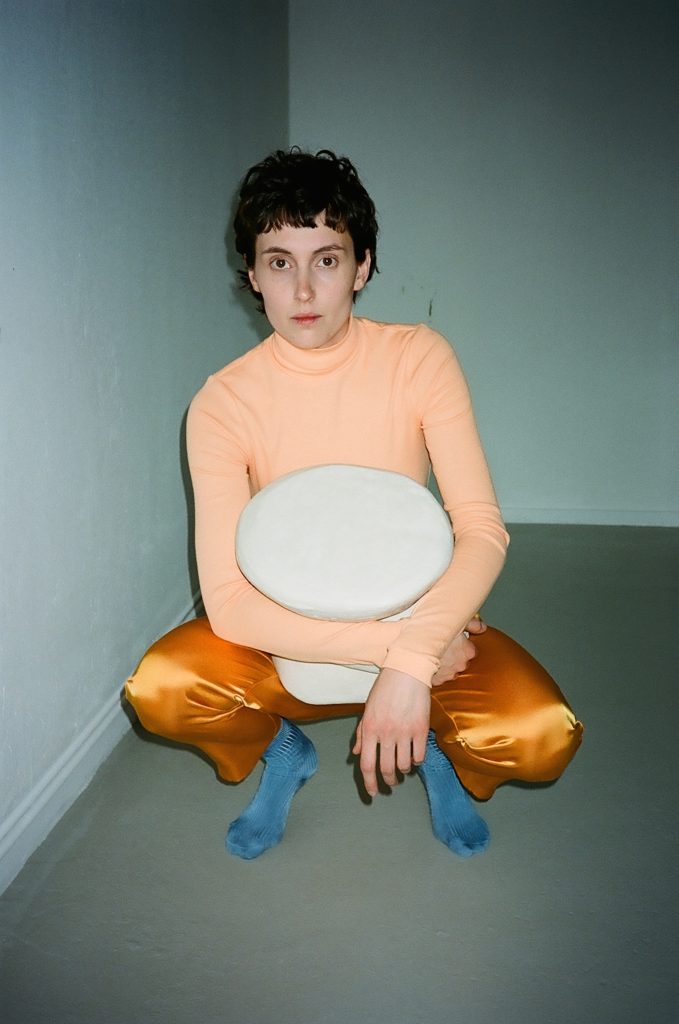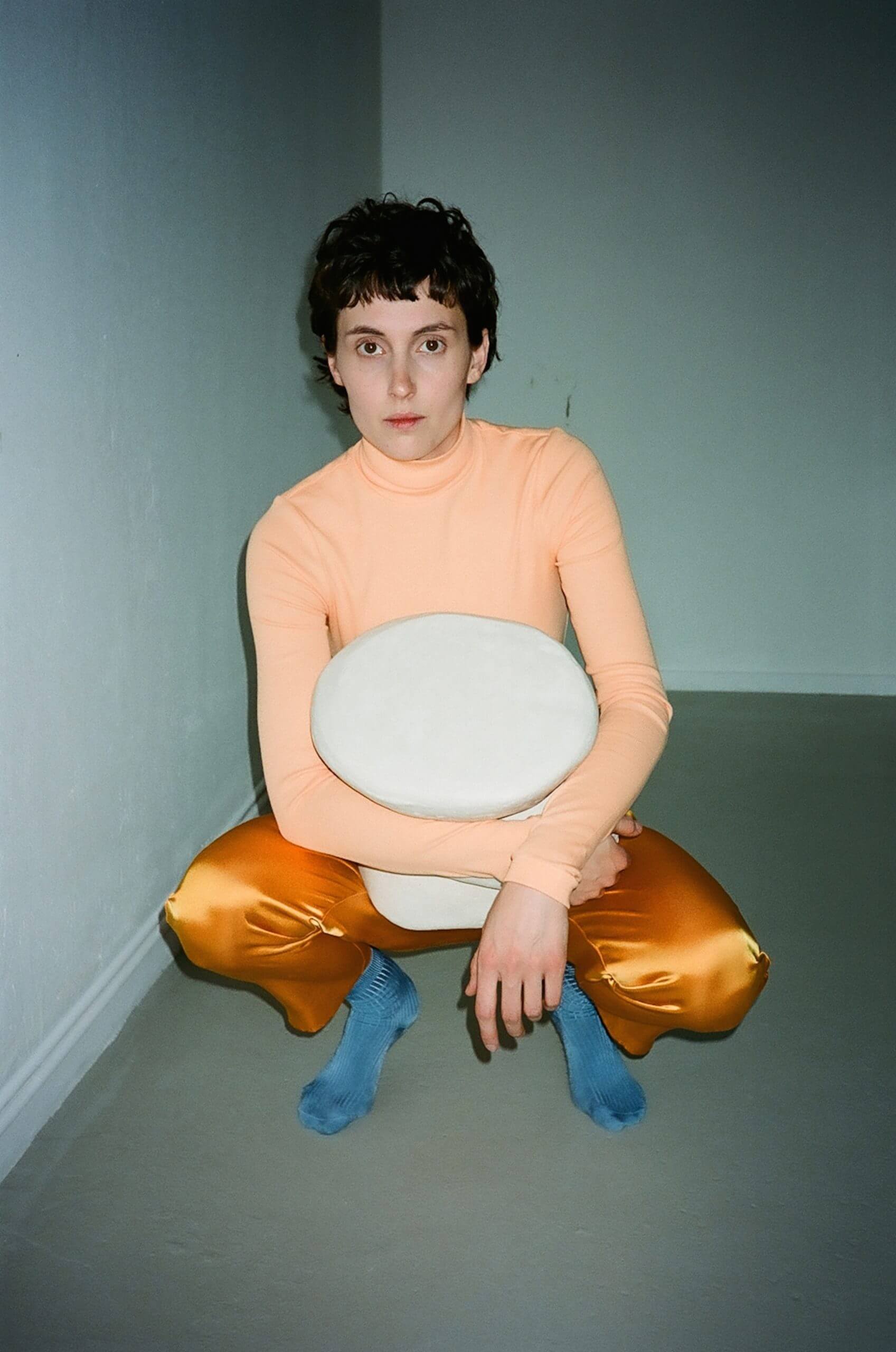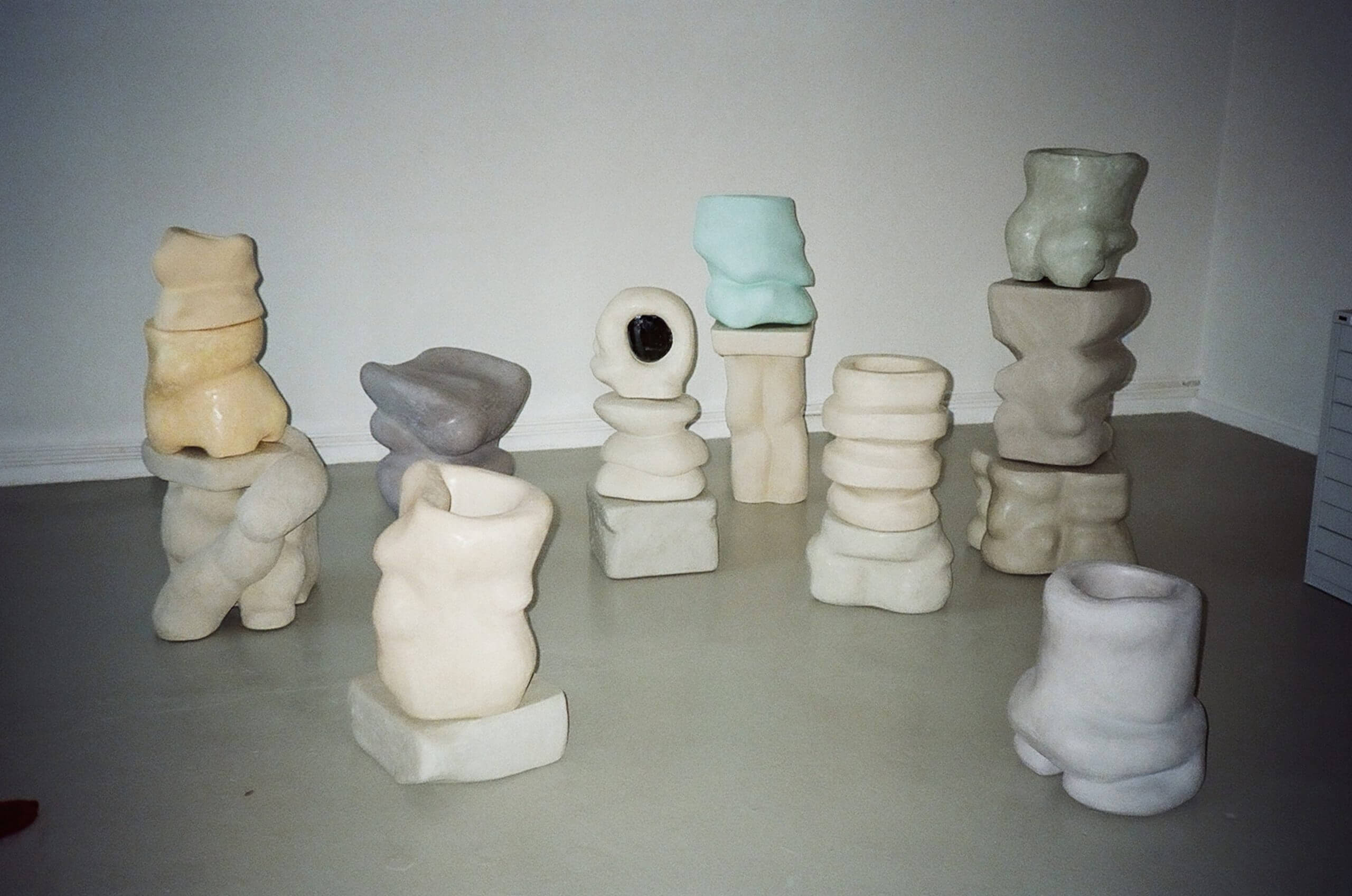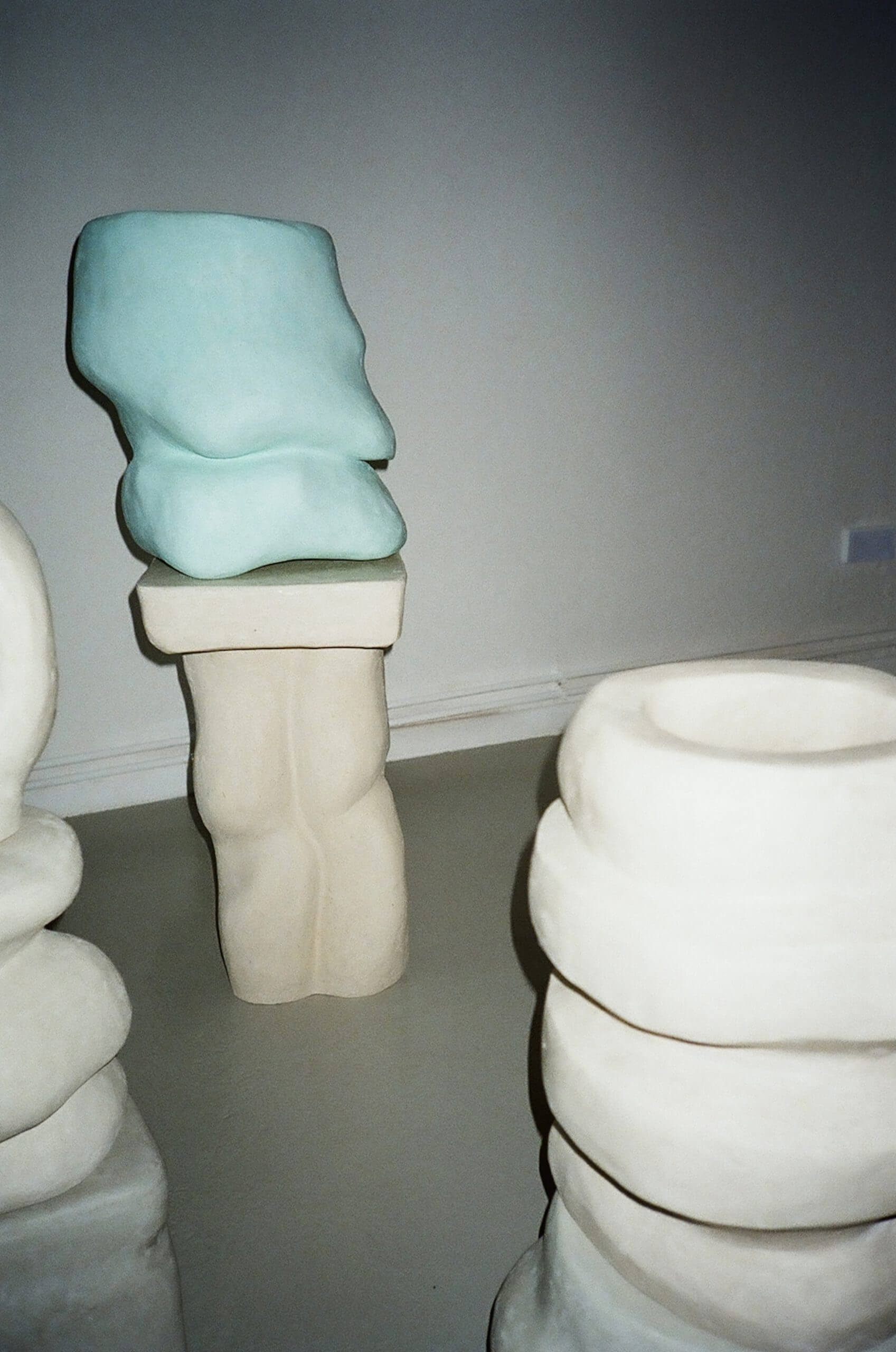Intuitive Creation with Yasmin Bawa

Experimentation, in terms of both medium and process, delineates Yasmin Bawa’s Berlin-based practice where she designs various objects, furniture and spaces. Evidently, instinctive trial and error pays off: Bawa’s instantly recognizable creations have gained traction as the design world navigates the shapes and materials of the future. Since her debut, Bawa has created multiple design series, collaborated with big names such as Soho House, and has become overall revered as a mainstay in the design sphere.
Bawa studied textile design and tailoring in London before taking a position at Acne Studios as a shoe designer. She branched away from fashion and eventually found herself experimenting with materials that could be moulded into objects, lighting installations, podiums and more. Through ceaseless research, Bawa uncovered the design potential for hemp-crete, the material she works with today in her studio. Not only is this hemp-lime mix lightweight, durable, and easy to work with, it binds carbon dioxide emissions within its material structure. In this way, Bawa’s objects are not just for viewing pleasure – they are effective small-scale carbon sinks.
FRONTRUNNER spoke to Yasmin Bawa about her creative journey, experimentation in her studio, and how her design philosophy has changed over the years.

I saw you got your start in fashion. How did you get into the industry?
I’ve always been on this path of constantly changing directions. I was in Edinburgh for high school, then I went to a textile school. From there I knew I wanted to do more design so I moved to London to keep studying and specialized in tailoring and printed textiles. I was doing a lot of internships and one of the designers I was working with put me forward for an assistant role at Acne. The position was for shoes and even though I hadn’t done accessories at all, I was like, “I can do shoes, sure”. I met with the designer and we really got along, so she took me on without actually having much experience, and I learned on the job. I’ve taken that mentality with me for a lot of things, just to roll with different projects and not to worry if you already have the exact skills you need.
And why did you leave fashion for industrial design and sculpture?
I graduated and got this job straight away, which was pretty crazy. I was there for a few years and during this time my role and responsibilities progressed rapidly. This was an amazing experience and I learned so much, but I also learned that the fashion cycle was moving too fast for me. I was getting frustrated because we were working on great designs, but didn’t have enough time to get them to the point where I was truly happy. I wanted time to do one more prototype, or to develop a design a bit more. Also the environmental side of fashion started to get to me. The quantities we were dealing with were impossible to even imagine. Yeah, just the combination of getting exhausted and a bit frustrated with the design cycle led me to drastically change.

Where do you find day-to-day inspiration for your creations – does fashion still inspire your work now?
I don’t take inspiration directly from fashion, however my time in fashion definitely has an influence on my work now. My graduate collection, for example, had a focus on geometric printed suits and sometimes I feel that my sculptures now are embodiments of those prints. Even though my work is so different now, there’s still something in there that I see in terms of what I’ve done before. Inspiration for me is more from research; I am constantly reading and researching about archaeology, architecture, natural building, natural materials and traditional building techniques and processes from around the world. There’s a bookstore around the corner from my studio, which I go to often, and it has an amazing selection of photography books. Usually there is one photography book from there that serves as an inspiration for a period of time. I don’t take direct inspiration from it, it is more of a general mood. I love these kinds of photo books with juxtaposed images.
Could you tell me more about how you discovered hemp-crete and why it’s your current medium of choice?
I knew I wanted to do some kind of cross between furniture and sculpture, but I was not sure what exactly. To make ends meet I was still freelancing in fashion a little bit and then I had set up a studio in my bedroom. I spent quite a few months researching as I really wanted to try to make furniture with different materials. I first experimented with concrete, which I really liked because you could mould it in so many different ways. I developed kind of a method with concrete, putting these small lightweight stones in it so I could mould the concrete around a form. But I only did a few pieces, and realized, I can’t work with this. I would have my hands super deep in concrete, and even with full protection it was so drying and it made me very aware of how toxic it can be. I started looking for something else, and in doing research, I found an interview of a family who built a house out of hemp-crete. It was named as an alternative to concrete – which it’s not – however, in my case, I was able to use it as a replacement for what I was doing with concrete. In general, there’s a movement now to not really use the term hemp-crete, because it has false connotations of being like concrete. We use hemp-lime now.
It says on your website your manufacturing method is a scaled-down version of home building techniques. Could you tell me more about your creative process?
Yes exactly, essentially when you build a house with the material you build one thick 30-40m wall of hemp-lime as insulation and then plaster your walls. My process is very similar to this. I also buy all my materials from a natural building home supplier instead of using materials from an art shop. The hemp shiv is the core of the stalk of the industrial hemp plant and it looks almost like woodchip, the outer part is where you get the fibres. You take hemp shiv and combine it with a lime based binder – you say lime based, because you can use different types of lime in the mix. From this mix you can form your shape and this dries to become a hard but lightweight material. After the main structure dries I can build up the plaster, and also at this stage I can change and develop the shape. The final layer is a fine lime which can be polished.
When you go into a hemp-lime house, there’s humidity control and you can really feel a special air quality. The walls are breathing so if there’s any moisture the vapour can escape instead of getting stuck in the walls. You have an environmentally friendly, sustainable material. You don’t have mould, you don’t have pests. Because the hemp plant grows so fast it takes in a lot of carbon, by using the material to build something permanent, you’re locking in that carbon opposed to it going into the atmosphere. Since the hemp shiv itself is carbon negative if you look at the total embodied energy of the final product, it could be possible to make something carbon neutral.

Could you tell me more about the Species of the Space series and your vision for this project?
The name is a play on words from my favourite book, Georges Perec’s Species of Spaces. I played with the name when I did the first series, and I just loved it! It describes exactly the feelings that I have; creating these sorts of creatures that live with you and cohabit a space. This book is all about observations of the everyday. My work is also not about designing one object, but many pieces that work together as a series and can be combined and stacked in different ways. How can a very simple square block look elevated with other pieces? Instead of doing a really tall podium, I like the idea of making smaller sections – and this way it comes together in a totally different way than if you just tried to make it as one piece. It is also not fixed, you can move it around and you can change it. This concept is also in the process of making the pieces; being really free, creating these shapes intuitively, then looking at it all together and seeing what the shapes have to say. At some point in the process of working on several pieces, there is a moment when I feel, now these pieces are a series. The series has actually continued over the last couple of years. Sometimes I think that I should come up with another title, but I also like that it keeps going, it’s my way of creating an undefined series.
Lastly, what does the future look like for you and your studio?
It looks bigger! I’m trying to figure out how to go bigger logistically, physically, and technically. I did a large interior project with an architectural firm, which was really great; they helped with the technical side and all the substructures and with such amazing support from them, the whole build went really smoothly. I would love to do another interior space like that. I also have a test in progress in my studio garden where we have built a large bench. I wanted to see how the finish would work outdoors – in theory, it should be fine – but it’s not something I’m comfortable doing for a client yet. I had some extra material so I thought, why don’t we just do something for our garden! So that’s a little test. Long term, I really want to build my own house out of hemp-crete!









Responses